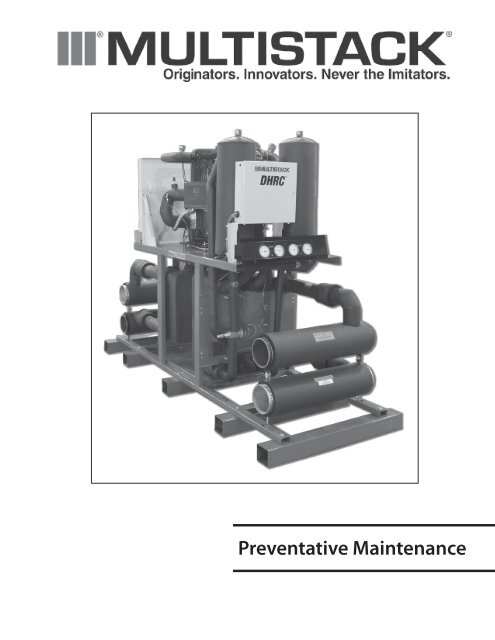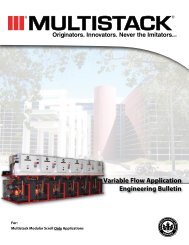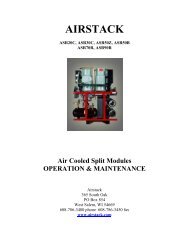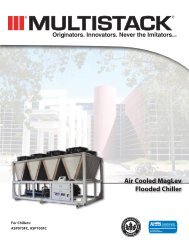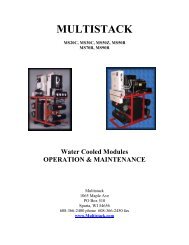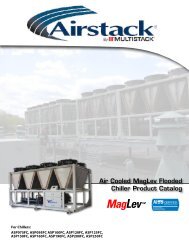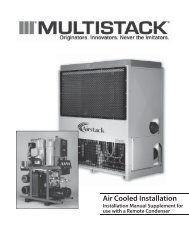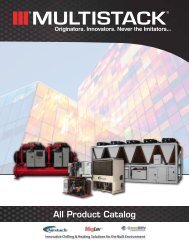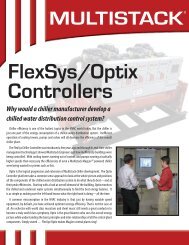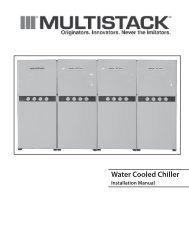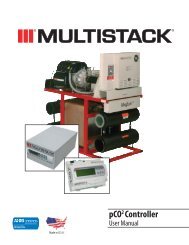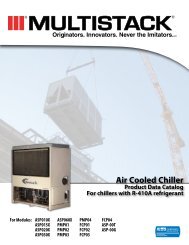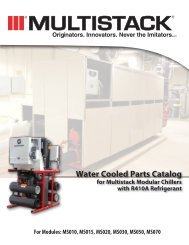Preventative Maintenance - Multistack
Preventative Maintenance - Multistack
Preventative Maintenance - Multistack
Create successful ePaper yourself
Turn your PDF publications into a flip-book with our unique Google optimized e-Paper software.
<strong>Preventative</strong> <strong>Maintenance</strong>
Brazed plate heat exchangers make each MULTISTACKmodule highly efficient. This side view of module,without cabinetry, shows the location of the heatexchangers.ANNUAL CLEANING PROCEDURE FOR SHUT-DOWN OF MULTISTACK CHILLERSMULTISTACK Chillers utilize Heat Exchangers that differ greatly in design, construction and performance from other types of heat exchangers (e.g., shell andtube design), and have completely different fouling characteristics. For best performance, MULTISTACK recommends taking the first step in fighting fouling:PREVENTION.FACTORS AFFECTING FOULING• Temperature • Velocity• Surface Finish • Turbulence• Flow Distribution • Water QualityTYPES OF FOULING: Scaling and ParticulateScalingScaling is caused by substances dissolved in the heat transfer medium which deposit on the heat transfer surface. To prevent or minimize scaling, a proper watertreatment program designed by a competent water treatment professional is recommended.ParticulateParticulate fouling is caused by solids in the heat transfer medium such as mud, silt, sand or other particles. Particulate fouling is affected by velocity, distributionof the medium, roughness of the heat transfer surface and the size of the particles. Particles can enter the heat exchanger through old rusty pipes or through thecooling tower.To reduce particulate fouling, MULTISTACK recommends a good filtration system (i.e., strainers, sand filters, mechanical/centrifugal separators).Note: A Teflon Coated Stainless Steel cartridge filter for the evaporator and condenser header is suppliedwith all MULTISTACK modules to remove particles. If required, other types of filtration systems can beadded to meet specific filtration parameters.LAMINAR VS. TURBULENT FLOWThe evaporator system is shown in this illustration.A complex series of channels within each heatexchanger gives rise to vigorous turbulence,ensuring maximum heat transfer.LaminarWhen a fluid passes through a tube the greatest velocity is at the center of the tube. The tube wall has no turbulence to keep particles in the fluid in suspension.These particles are allowed to precipitate out and collect on the tube wall which causes fouling of the heat transfer surface. Conventional types of heat exchangersare very sensitive to low velocities and easily get into he laminar region.2
Turbulent FlowThe opposite of laminar is turbulent flow. Operating with turbulent flow is the best way to avoid fouling in the heat exchangers.MULTISTACK Chillers dispense a high degree of turbulence to the fluid which keeps particles in the fluid in suspension, and actually performs a scouring actionto help keep the heat transfer surface clean. This is accomplished by the unique design of the MULTISTACK Heat Exchanger. As the water passes throughthe channels it is constantly changing direction and velocity, disturbing the boundary layer and creating turbulent flow even at low velocities. Therefore, theMULTISTACK Modular Water Chiller will always operate with fully developed turbulence.PREVENTIVE MAINTENANCEAnnual cleaning of the heat exchangers is recommended. If the chiller is shut down for non-cooling season, the following cleaning procedure should be performedat time of shut down:1. Isolate chiller (both condenser and chilled water circuits).2. Drain chiller.3. Backflush chiller with water to remove foreign material.4. Fill chiller with clean water.WARNING: Do not sue hydrochloric or sulfuric acid for cleaning any MULTISTACK Heat Exchangers. Makesure any chemical used are compatible with copper and stainless steel.NOTE: Operating conditions may indicate more frequent cleaning is required. A rise in dischargepressure to above 420 psi (at normal condenser water temperature) or a reduction in evaporator heattransfer, low suction pressure, and low chilled water temperatures are examples of such indicators.If the above procedure does not restore normal operating conditions, consult the MULTISTACK HeatExchanger Cleaning Procedures.CORROSION RESISTANCECorrosion is a complex process influenced by many different factors. Although stainless steels are considered corrosive resistance, AISI 316 and 316L stainless steelare not resistant to chloride concentrations above 300 parts per million (ppm). MULTISTACK Heat Exchangers are made of stainless steel plates brazed togetherwith copper (99.9%).CAUTION: Knowing the chloride content of your supply water is essential. A qualified water treatmentprofessional should test your water for chloride levels and treat the water accordingly.CAUTION: Chloride concentrations above 300 ppm will damage stainless steel heat exchangers.CAUTION: Do not add any chemical to the water without consulting with a water treatment professionalto make sure that treatment is compatible with all materials in the system including copper and stainlesssteel. Do not use sulfuric or hydrochloric acid.3
MULTISTACK TROUBLESHOOTING GUIDESOURCE OF CONTAMINANTSPOSSIBLE SOLUTIONWater Impurities• Oil• Oil film build-up in the condenser or evaporator will reduce the transfer.• Chlorides• Chlorides entering the condenser of evaporator will corrode the brazedplate heat exchangers.• pH-Level• High acid levels entering the condenser or evaporator will cause corrosion.• Calcium• Calcium build-up in the condenser will reduce the heat transfer, as wellas water flow through the system.1. Organic materials can be removed with detergent cleaning.2. Maintain chloride levels below 300 ppm.3. pH levels should be maintained between 7 and 9.4. Inorganic contaminants can be removed by mild cleaning withphosphoric or sulfamic acid (e.g. Nu-Calgon Imperial Scale Remover PartNumber 4360-84).DO NOT USE HYDROCHLORIC OR SULFURIC ACID5. Have a water treatment contractor test your water and recommend aproper treatment plan.6. Make sure the contractor is familiar with the components of the system(e.g., 316 stainless steel heat exchanger, and copper brazing material).System Impurities• Rust• Pipe Scale• Welding Slag and Other Debris• Internal contaminant present in the water pipes can enter theMULTISTACK condenser or evaporator, plugging up the filters andultimately the heat exchangers.Cooling Tower Impurities• Grass• Algae• Tower Fill• Air-born Soot and Dirt• Insects• Cottonwood Seeds• Construction Debris• External contaminants enter the condenser of the MULTISTACK modulethrough the cooling tower.1. When installing a new chiller, acid wash the condenser and evaporatorwater loop system before connecting the water pipes to the MULTISTACKunit.2. During normal system operation, observe the discharge pressure andclean filters if head pressures approach 450 psi (high pressure cut out trips at 475 psi).1. A filter (polyester or wire mesh) over the air inlet to the cooling towerwill help prevent external contaminants from entering the cooling tower.2. Drain and clean cooling towers as required.3. Whenever possible, avoid placing cooling towers in close proximity totrees, smoke stacks or outside lights.1064 Maple Avenue Sparta, WI • P 608-366-2400 • F 608-366-2450www.multistack.comF125PM0909


